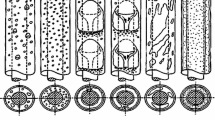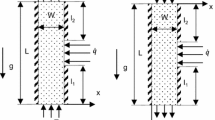Abstract
A model is presented of the interphasic heat and mass transfer in the presence of noncondensable gases for the KORSAR/GP design code. This code was developed by FGUP NITI and the special design bureau OKB Gidropress. It was certified by Rostekhnadzor in 2009 for numerical substantiation of the safety of reactor installations with VVER reactors. The model is based on the assumption that there are three types of interphasic heat and mass transfer of the vapor component: vapor condensation or evaporation on the interphase under any thermodynamic conditions of the phases, pool boiling of the liquid superheated above the saturation temperature at the total pressure, and spontaneous condensation in the volume of gas phase supercooled below the saturation temperature at the vapor partial pressure. Condensation and evaporation on the interphase continuously occur in a two-phase flow and control the time response of the interphase heat and mass transfer. Boiling and spontaneous condensation take place only at the metastable condition of the phases and run at a quite high speed. The procedure used for calculating condensation and evaporation on the interphase accounts for the combined diffusion and thermal resistance of mass transfer in all regimes of the two-phase flow. The proposed approach accounts for, in a natural manner, a decrease in the rate of steam condensation (or generation) in the presence of noncondensing components in the gas phase due to a decrease (or increase) in the interphase temperature relative to the saturation temperature at the vapor partial pressure. The model of the interphase heat transfer also accounts for the processes of dissolution or release of noncondensing components in or from the liquid. The gas concentration at the interphase and on the saturation curve is calculated by the Henry law. The mass transfer coefficient in gas dissolution is based on the heat and mass transfer analogy. Results are presented of the verification of the interphase heat and mass transfer used in the KORSAR/GP code based on the data on film condensation of steam-air flows in vertical pipes. The proposed model was also tested by solving a problem of nitrogen release from a supersaturated water solution.
Similar content being viewed by others
References
The RELAP5 Development Team, RELAP5/MOD3 Code Manual, Vol. I: Code Structure, System Models and Solution Methods. NUREG/CR-5535-V1 (Idaho National Lab., Idaho, 1995).
I. Dor, G. Geffraye, G. Lavialle, and T. Mieusset, “Recent improvements of physical models in the CATHARE code and their validation,” in Proc. 12th Int. Conf. on Nuclear Engineering (ICONE12), Arlington, VA, Apr. 25–29, 2004 (Am. Soc. Mech. Eng., 2004), Vol. 3, pp. 681–691, paper no. ICONE12-49408.
TRAC-PF1/MOD2 Theory Manual (Los Alamos National Lab., Los Alamos, NM, 1993).
V. A. Vasilenko, Yu. A. Migrov, S. N. Volkova, Yu. V. Yudov, I. G. Danilov, V. G. Korotaev, V. V. Kut’in, B. R. Bondarchik, and D. V. Benediktov, “Experience in creating the thermohydraulic computer code of the new generation KORSAR and its main characteristics,” Therm. Eng. 49, 888–894 (2002).
Yu. V. Yudov, “A two-fluid model of unsteady circuit thermohydraulics and its numerical realization in the KORSAR computer code,” Therm. Eng. 49, 895–900 (2002).
D. A. Frank-Kamenetskii, Diffusion and Heat Transfer in Chemical Kinetics (Nauka, Moscow, 1987; SpringerVerlag, New York, 1995).
S. Kuhn, V. Schrock, and P. Peterson, “An investigation of condensation from steam-gas mixtures flowing downward inside a vertical tube,” in Proc. 7th Int. Meeting on Nuclear Reactor Thermal-Hydraulics (NURETH-7), Saratoga Springs, NY, Sept. 10–15, 1995 (U.S. Nucl. Regul. Comm., Washington, DC, 1995).
A. Dehbi and S. Guentay, “A model for the performance of a vertical tube condenser in the presence of noncondensable gases,” Nucl. Eng. Des. 177, 41–52 (1997).
Author information
Authors and Affiliations
Corresponding author
Additional information
Original Russian Text © Yu.V. Yudov, 2018, published in Teploenergetika.
Rights and permissions
About this article
Cite this article
Yudov, Y.V. Accounting for the Effect of Noncondensing Gases on Interphasic Heat and Mass Transfer in the Two-Fluid Model Used in the KORSAR Code. Therm. Eng. 65, 160–167 (2018). https://doi.org/10.1134/S0040601518030072
Received:
Accepted:
Published:
Issue Date:
DOI: https://doi.org/10.1134/S0040601518030072




